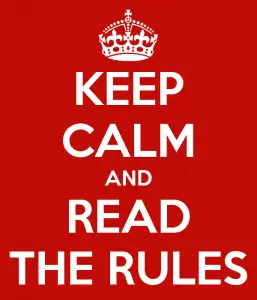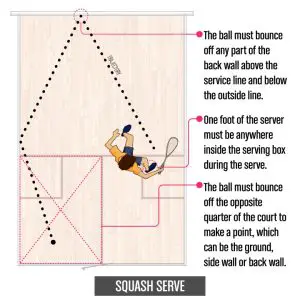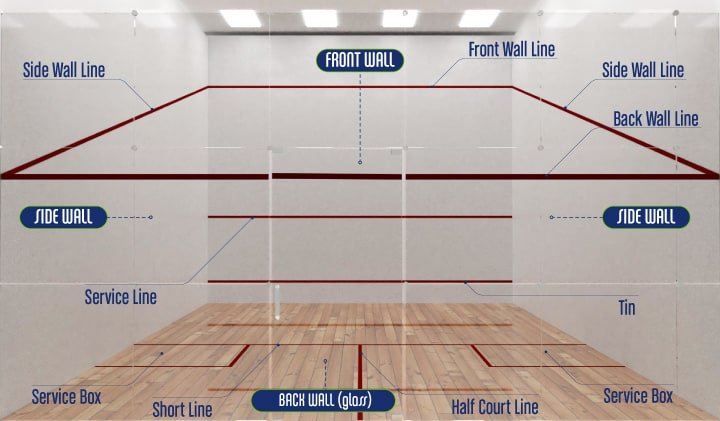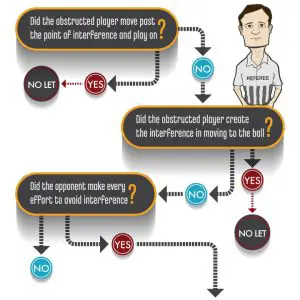[Updated on 1 January 2024] The World Squash Federation (Found here at: http://www.worldsquash.org) provide, freely available, documents for the official Squash rules. Now for most people, the detailed list of squash rules is far too much for nearly all of us to pay attention too! They are designed for professionals:
- Players (Professionals, Club, Juniors)
- Umpires
- Matches (Professional, Tournament, Club)
They have kindly made available an abbreviated form for the rest of us which you can check out here: Squash Rules Abbreviated.
Now, this version is more than suitable for those who have been playing for at least 6-12 months and understand the key points to the game. But, there is not a version for beginners. Easy to follow, straight up advice.
I’m hoping to fill that gap here by abbreviating the WSF’s abbreviated rules down even further. As such, if you are new to Squash and looking for some easy to understand rules, look no further.
This summary will help you get a game going with your friends, and when you feel comfortable I recommend you read through the abbreviated game once you find that these are not enough. Happy reading and happy squashing!

Squash Rules – The Abbreviated Abbreviated Version
These are based on the WSF (World Squash Federation) Abbreviated Rules of Squash, applicable for 2020. This is MY interpretation & have created it solely to assist new players with enjoying the game of Squash. If you find that this does not provide enough information, please see the WSF’s rules, linked above.
NOTE: These rules may differ around the world. I know for a fact (considering I live and play there) that North American rules were different at one time than international rules! When you first join a competitive league, make sure you know THEIR RULES!
With that out of the way, lets begin.
Terminology
A glossary of some of the basic terms above and that you’ll start to hear around the squash club.
 Serve – starting a rally by hitting the ball (underarm or overarm) against the front wall.
Serve – starting a rally by hitting the ball (underarm or overarm) against the front wall.- Nick – the area where the side walls meet the floor, if the ball hits this area, it is usually an outright winner
- Let – when a rally breaks down due to interference, a let decision can be made when neither player is at fault and sees the rally replayed.
- Stroke – when a rally breaks down due to interference and the incoming player’s swing is prevented by the re-treating player, a stroke is called and the incoming player win the point.
- No Let – when a rally breaks down due to interference and the incoming player is deemed to have made minimal effort to play the ball, while the outgoing player has made every effort to clear a path to the ball, a no let is called and the outgoing player wins the point.
- Out line – the line running around the top of the court. If the ball hits the red line that marks the top of the court then it’s out.
- Service line – the line on the front wall in between the tin and out lines.
- Tin – the area below the lowest red line on the front wall. If the ball hits this line or below then it’s out.

- The T – the T shape in the middle of the court where the lines meet and denotes the strongest place to be during a rally.
SCORING
- A match is won by winning the best of 5 games. That is, if you win 3 games out of the 5, you win the match.
- Games are played to 11 points. Unless a game gets to 10-10, or 10 points each. At that point, the game continues until a player is ahead by 2 points. That is, 12-10, or 13-11, 14-12. etc. (games are played to 9 in Australia!)
- Whoever wins the point, scores a point. Whether you are a server or not. If the server wins the point, the remain as the server. If the receiver wins the point, they become the new server! (In Australia, you can only win points by being the server!)
Pre-Game Warm Up
 A FIVE (5) minute warm up between both players & the ball occurs before the start of the match. You are on respective sides of the court & hit the ball against the wall to each other & back again.
A FIVE (5) minute warm up between both players & the ball occurs before the start of the match. You are on respective sides of the court & hit the ball against the wall to each other & back again.- Switch after 2 and a half minutes so that you both warm up each side equally.
Service
Each ball (point) begins with a serve. Much akin to Tennis. On the first point of a match, the server is decided by spinning a racket on the tip of its head.
Choose which face of the racquet you think will face up upon its landing. If you are correct you serve first, if not, your opponent serves first. Consider it like flipping a coin.
- The server remains the server until he/she loses the point. Upon which, the other player becomes the server.
- The server may choose which side of the court that they will serve from first. After the first point (assuming they won it), they will then serve from the opposite side to that which they just served from. That is, they alternate serving sides. Much like Tennis.
For a serve to be good, three things need to occur.
- Firstly, at least PART of the servers foot must be in side the smaller of the squares on their side of the court (service box).
- Secondly, there serve must directly hit the front wall ABOVE the service line (middle line) and BELOW the outline (the top line).
- Thirdly, the ball must bounce in the opposite rear quarter of the court (the quarter that your opponent will be standing in).

NOTE 1: After the ball has hit the front wall in the appropriate location, it can then hit any of the other walls (within the boundaries – below the top walls & without hitting the ground!) before it lands in your opponent’s rear quarter.
NOTE 2: Serves can be hit in any way shape or form that you wish! If you want to under arm hit it, go ahead. Tennis style & over arm? Smash away! Experiment with different styles, approaches & strengths. The serve is a very powerful part of the game, do not underestimate it & utilize it to your utmost potential!
Good Returns
The person returning the ball must strike it BEFORE the ball bounces on the ground twice. Volleys, and strikes after one bounce on the ground are OK.
The ball, upon being struck can hit any of the side and rear walls (within the boundaries – above the ground & below the top out mark) before hitting the front wall. The ball can only hit the front wall ABOVE the tin (bottom out mark) & BELOW the top out mark.
If the ball hits any of the out lines (even partially) it can be considered OUT and the point has been LOST.
Rallies
A rally includes the service & any strokes played before the rally is lost. A rally can be known as a point or a ball.
A Rally can be lost through a number of ways, listed below:
- A double bounce on the ground before the ball is returned.
- A ball lands out of play (above the out lines or below the ‘tin’ line at the front wall).
- If the ball, upon returning from the front wall, hits the person who just struck the wall anywhere on themselves, their clothing or their racquet. (This results in other other players point or win).
If the ball cannot be played due to ANY danger that playing the ball may result in it striking the opponent. At this point, the player must call “LET PLEASE”.
- If it is determined that the player who called let could have hit a clean stroke to the front wall if the opponent was not in the way then it can be considered a “Stroke” and the play will be rewarded the point (win)
- It is deemed that the player could have returned the ball, but only through hitting either the side or back walls then it is considered a “Let” and the point must be replayed.
- If it is deemed that the return could not have been good at all, then it is “No Let” and the opponent wins the rally due to calling an unnecessary “Let”.
NOTE: Lets can be a sensitive issue due to the amount of personnel perspective & opinion involved. In the case of a friendly match or social match. Be the bigger person & don’t argue the point for too long. It will make the game less fun! If the game is competitive & is played in a Pennants league, the umpire is ALWAYS right. You can question the point, but don’t take it to heart. Move on and win the next point!
If a player strikes the ball & it hits the other opponent, the same three rules should be used to determine the resulting point. Always call “LET PLEASE” if in doubt though.
Squash can be a dangerous and painful sport if played recklessly. It is also very unsporting if a player repeatedly takes dangerous strikes & points may be deducted in competitive matches for repeat offenses.
Turning
- Turning in squash occurs when the ball passes around a player, from left to right, or right to left. Forcing the player to follow the ball, and turning around to follow it. During this it is easy to lose track of your opponent & often means that the player will in fact be facing their opponent.
- Due to the danger of this, if a player turns, it is best to call “LET PLEASE” and a let must be given in this case and the point will be replayed.
- If the player turns and strikes the ball, and it ball hits their opponent, due to the dangerous movement of the play, the point & win is awarded to the opponent, not the striker. It in effect is a punishment to deter players from taking dangerous swings!
More on LETS!
A player looking to strike the ball is entitled to FREEDOM FROM OBSTRUCTION or freedom from interference. Freedom from obstruction requires the following things:
 Unobstructed access to the ball (Move out of your opponents way)
Unobstructed access to the ball (Move out of your opponents way)- View of the ball (Move out of your opponents way)
- Space to swing (Move out of your opponents way)
- Able to play the ball to any part of the front wall (Move out of your opponents way)
In conclusion… Move out of your Opponents way 🙂
If you are the striker, and find your opponent is in the way, call “Let Please” & stop play OR play on. The preference is to stop play and call “Let Please”.
A stroke will be awarded to the striker if the opponent:
- Doesn’t make every effort to get out of the way
- Could have hit a winning shot
- If the striker would have hit the opponent on going for the front wall.
A Let is awarded if:
- If the striker could have returned the ball & the opponent has made every effort to get out of the way.
NO LET is awarded if:
- If the striker could not have returned the ball.
- Plays on. A let must be called before swinging for the ball.
- If there was no actual interference
Finally, a summary on the call and corresponding point allotment:
- No points awarded for a let, the point is replayed from the beginning with the original server still serving.
- A point is awarded for a stroke (to whomever it is towards)
- A no let call results in a point for whoever was in the right.
Lets are applicable if something interferes on court (another ball landing in your court) or if your ball breaks during play. There are numerous other reasons, be sensible about them.
The Fun Rule
1) This isn’t a WSF rule, it is actually mine. Simply put, have fun out there. Sure get competitive and fight hard for every return, but at the end of the day remember that it is in fact, JUST A GAME. One which you should enjoy every second of because it means you are not at work!!
Done & Dusted – Now Go and Play!
Well there you go! I hope that helps you get you on your way to a clean, fun game of squash.
The rules are there to help you play. My advice is take a few of the simpler ones, such as serving & point keeping and play with them first. Add a few new rules for every game you play so that your mind doesn’t get too muddled. There is a lot to learn, and trust me on this, there are even more nuances to this amazingly complex game.
My sincerest welcome to Squash, enjoy your stay. It’s going to be a long and fruitful one!!
If you would like to read some of my other articles, continue through my website it is filled with, squash tips & what not, please feel browse and comment as you please.
If you have any comments, please drop a line. Suggest an article, ask a question.
Leave a Reply